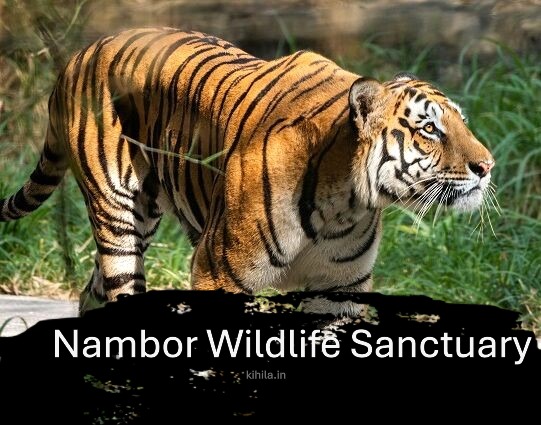Introduction
Nestled in the lush greenery of Karbi Anglong, Nambor Wildlife Sanctuary is a remarkable haven for biodiversity. Spanning 37 square kilometers, this sanctuary is home to a variety of flora and fauna, making it an important ecological hotspot in Assam. Recognized as a wildlife sanctuary on July 27, 2000, it plays a crucial role in preserving rare and endangered species. With its dense tropical forests, rich biodiversity, and unique climatic conditions, this sanctuary stands out as a must-know location for nature enthusiasts and researchers alike.
Unique Ecosystem and Climate
Nambor Wildlife Sanctuary is known for its diverse landscapes, including tropical forests and low-lying plains. The region receives an annual rainfall of approximately 120 cm, creating an environment conducive to the growth of dense vegetation. The temperature here ranges from a cool 7°C in winter to a warm 30°C during summer, maintaining a balanced climate that supports a wide range of wildlife species.
Home to Majestic Mammals
The sanctuary provides shelter to an incredible variety of mammals, some of which are rare and endangered. Among the prominent species found here are:
- Royal Bengal Tiger – The apex predator of the region, playing a crucial role in the ecosystem.
- Indian Elephant – A significant species in Assam, often seen wandering through the dense forests.
- Hoolock Gibbon – India’s only ape species, known for its distinct calls and swinging movements.
- Golden Langur – A rare primate species found in select regions of Assam and Bhutan.
- Leopards, Sambar Deer, Barking Deer, Gaur (Indian Bison), Wild Boar, Porcupine, and Jackals also call this sanctuary home, creating a dynamic and thriving wildlife population.
A Birdwatcher’s Paradise
For bird lovers, Nambor Wildlife Sanctuary is an unmissable destination. The sanctuary hosts numerous species of both migratory and resident birds, making it a significant avian hotspot in Assam. Some of the most commonly spotted birds include:
- Great Pied Hornbill – A symbol of Assam’s wildlife heritage, known for its striking appearance and loud calls.
- Imperial Pigeon – A large, colorful bird that adds vibrancy to the forest canopy.
- Hill Myna, Green Pigeon, Jungle Fowl, Pheasants, Magpies, Parrots, and Rock Doves are among the other feathered residents of the sanctuary.
- The sanctuary also provides habitat to several species of raptors, including hawks and eagles, making it an ideal spot for birdwatching.
Rare and Exotic Flora
Nambor Wildlife Sanctuary is not just about wildlife; its flora is equally impressive. The dense forests are home to an array of timber species, including:
- Bhelu, Gomari, Ajar, Nahor, Udiyam, Poma, and Bon Som – All valuable timber species contributing to the sanctuary’s ecological importance.
- The region is particularly known for its rare orchids, ferns, and climbers, making it a treasure trove for botanists and researchers.
Insect and Butterfly Diversity
Entomologists and butterfly enthusiasts find Nambor Wildlife Sanctuary a fascinating research ground. The area supports a variety of insect species, including:
- Colorful butterflies that flutter around the sanctuary, adding to its beauty.
- Moths and beetles that play essential roles in pollination and ecosystem balance.
Best Time to Visit
The most favorable months to explore the sanctuary are from November to April, when the weather is pleasant, and animal sightings are more frequent. During this period, migratory birds also visit the region, making it a prime time for birdwatching.
Safari Timings
To witness the best of wildlife activity, it is advisable to visit during the designated safari hours:
- Morning Safari: 6:00 AM – 9:00 AM
- Evening Safari: 3:00 PM – 5:00 PM
These time slots provide the best chances to spot animals in their natural habitat as they are most active during these hours.
Importance of Conservation
Nambor Wildlife Sanctuary plays a significant role in preserving Assam’s rich biodiversity. As human activities continue to impact natural habitats, protected areas like this sanctuary serve as a refuge for endangered species. Conservation efforts ensure the survival of wildlife while maintaining the ecological balance of the region.
Final Thoughts
Nambor Wildlife Sanctuary stands out as an essential part of Assam’s environmental heritage. With its rich wildlife, diverse plant species, and serene landscapes, it offers an incredible opportunity to learn about nature’s wonders. Whether it’s the majestic tigers, vibrant birds, or the exotic orchids, every aspect of this sanctuary contributes to its uniqueness, making it a vital ecological treasure.
FAQ’s:
Where is Nambor Wildlife Sanctuary located?
Nambor Wildlife Sanctuary is in the Karbi Anglong district of Assam, India. It is about 25 km from Golaghat and 65 km from Kaziranga National Park.
What makes Nambor Wildlife Sanctuary special?
This sanctuary is known for its rich biodiversity, including Royal Bengal Tigers, elephants, rare birds, and exotic orchids. The lush green forests and diverse wildlife make it an important conservation area.
Which animals can be found in the sanctuary?
The sanctuary is home to tigers, leopards, elephants, deer, Hoolock gibbons, golden langurs, wild boars, and many more species. It also has various birds like hornbills, jungle fowl, and imperial pigeons.
What is the best time to visit Nambor Wildlife Sanctuary?
The best time to visit is between November and April. During this period, the weather is pleasant, and there are higher chances of spotting wildlife.
Are safaris available in Nambor Wildlife Sanctuary?
Yes, safaris are conducted in the sanctuary. The ideal time to explore is early in the morning from 6:00 AM to 9:00 AM or in the evening from 3:00 PM to 5:00 PM.
Is Nambor Wildlife Sanctuary good for birdwatching?
Yes, it is a paradise for birdwatchers. The sanctuary has a wide variety of birds, including the Great Pied Hornbill, Green Pigeon, and Hill Myna, making it an excellent place for bird lovers.
What type of forest covers Nambor Wildlife Sanctuary?
The sanctuary is covered with tropical forests, which include tall trees, ferns, and rare orchids. The dense vegetation provides shelter to numerous animals and birds.
What is the climate like in the sanctuary?
The climate remains moderate throughout the year. The temperature ranges from 7°C in winter to 30°C in summer, with an annual rainfall of around 120 cm.
How is Nambor Wildlife Sanctuary helping in conservation?
The sanctuary plays a major role in protecting endangered species and maintaining ecological balance. It provides a safe habitat for wildlife and supports conservation programs.
Are there any rare plant species in Nambor Wildlife Sanctuary?
Yes, the sanctuary is home to rare orchids, ferns, and several valuable timber trees like Bhelu, Gomari, and Nahor. These plants contribute to the sanctuary’s rich biodiversity.












